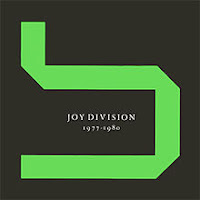So I thought I'd listen to the Joy Division back catalogue and look for clues to a happier, less grumpy world view. I failed, so instead here's a playlist I came up with for Mrs S a few years ago, highlighting my ten favourite Joy Division tracks. Note that 'Love Will Tear Us Apart' doesn't feature; I love that song, but it's a bit 'obvious'.
Unknown Pleasures

1. New Dawn Fades
2. She's Lost Control
3. Interzone
I recall buying Unknown Pleasures after saying farewell to my then-girlfriend as she set off on a train back to her home; something about the goodbye must have made me think 'Right, now's the time to finally buy Unknown Pleasures', for that's exactly what I did.
'New Dawn Fades' was a song I first heard covered by Moby. Whereas his version was angry, buzzing with a distorted aggression, Joy Division's version is far sparser, lots of reverb masking the gaps. It's certainly heartfelt, tragic and almost disturbingly negative. 'She's Lost Control' has some of the most inventive drum processing by Martin Hannett or any other producer, creating a sound not dissimilar to spraying aerosols (instead of using cymbals) and banging pipes (instead of using snares). Hooky's muted bassline dominates until reedy, inchoate guitars ascend. Curtis's lyrics detail flashes of madness from the female subject of the song. This was punk turned inside out – all the traces are there, yet none of them are.
Joy Division referenced William S Burroughs on 'Interzone', this being the disturbing parallel nightmare world of his Naked Lunch novel. This is just about the most straightahead punk track Joy Division ever produced, all snarling overdriven guitars and urgent drums; but the lyrics – two parallel sets in the left and right channels. Even when passed through Hannett's unique, and occasionally overbearing, filter this punchy little track never loses its raw appeal. To hear this in an even rawer state (without the double vocals), check out the Stooges-esque demo version that emerged from when the band were still called Warsaw.
Closer

4. A Means To An End
5. Decades
I bought my Joy Division collection in the wrong order, starting with their second (and technically final) album, Closer. Having been a New Order fan by then for some time, the album was initially confusing – delicately maudlin and introspective. Not quite ready for that degree of misery, I gravitated toward these two tracks: 'A Means To An End' for its buzzing guitars and earnest pulse, a definitive take on punk's spirit delivered in a more controlled manner; and 'Decades' for its fragile keyboards and slow build, its plaintive vocal refrains and its captivating grandeur (the keyboards on the live version I also have do tend to get a bit wonky and out of tune).
Still

6. The Sound Of Music
7. Dead Souls
The Still compilation chiefly reminds me of the first term of my university third year, and arriving back feeling miserable and lost. Still became the soundtrack to those first few weeks. Still was a posthumous collection of tracks not properly recorded, plus live songs (including the band's seminal take on Velvet Underground's 'Sister Ray' and most of their last ever concert in Birmingham), all polished into decent shape by Martin Hannett. 'The Sound Of Music' has a trudging, slightly phased beat and scratchy, restrained guitars that wouldn't have gone amiss on a Wire album c. 1978.
I first heard 'Dead Souls' when it was covered by Nine Inch Nails for The Crow soundtrack. The steady drum patterns here are again gently phased, giving Stephen Morris's kit the sound of a drum machine. Unlike most Joy Division tracks, the intro has an extended instrumental interplay between Bernard Sumner's guitar cascades and Peter Hook's elastic bass. If it wasn't slowed down to a sludgy, dystopian pace, it would almost have a punk-funk sound a la Gang Of Four. It is a wondrously bleak track.
Substance

8. Digital
9. Transmission
10. Atmosphere
Substance, like the 2CD New Order album of the same name, gathers together singles and other odds and ends not featured on other albums. 'Transmission' was the band's début Factory Records single. It sounds like post-Devoto Buzzcocks and comes across as reasonably upbeat – at first – but includes quotes from self-styled Satanic guru Aleister Crowley; as the track progresses what at first sounded euphoric becomes more dark. 'Dance, dance, dance, dance, dance to the radio,' implores Curtis, ever more urgently. Deborah Curtis' book was titled after a line in this song. 'Digital' is far too joyous to fit the mood of their two LPs; it has one of the most infectious basslines I've ever heard, plus an urgent motorik beat and some fine staccato guitar. The track was recorded in their very first sessions and included on the first Factory Records sampler double 7" EP. (I have had this song in my head all week.)
'Atmosphere' is a towering work of genius, relying heavily on Hannett's skills as a producer to create one of the best torch songs of the era. Curtis gives his best attempt at an impassioned Scott Walker vocal, drums pound in the distance, bass notes float in and out and the origin of New Order's distinctive keyboard sound rise up from the depths. It never fails to send a chill. There is hope somewhere in this song, but it's elusive. Definitely elusive.


No comments:
Post a Comment